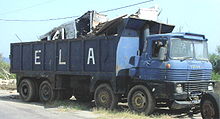Scammell Lorries



Scammell Lorries Limited was a British manufacturer of trucks, particularly specialist and military off-highway vehicles, from 1921 to 1988.
History
Scammell started as a late-Victorian period wheelwright and coach-building business in Spitalfields, London.
The outbreak of war in 1914 presented itself as a turning point in road transport history. Mechanical transport was seen to work, proving its vast potential beyond doubt to forward thinking companies such as Scammell. George Scammell’s great nephew, Lt Col Alfred Scammell was injured and invalided out of the army and he was able to apply the practical experience he had gained during the war and began developing the articulated six wheeler, which began production in 1920. This vehicle was articulated and its very low axle weight allowed it to carry 7½ ton payload at 12mph rather than being limited to 5mph [1].
In 1921, the company exhibited its first articulated vehicle, capable of carrying 7.5 tons, at the Olympia Motor Show. With the demand for this vehicle, the company first moved to a new works in Watford, and then formed Scammell Lorries Ltd in July 1922.
In 1929, Scammell designed and manufactured the "100 Tonner" low loader. Only two were produced, the first was delivered to Marston Road Services, Liverpool, for the transportation of steam engines to Liverpool docks.
Scammell were also looking for new markets, and diversified into four and six wheel rigids. The ‘Rigid Six-wheeler’ found some success and, with its balloon tyres, at last permitted sustained high-speed long-distance road operation.
In 1934, Scammell produced the 3-wheeled 'Mechanical Horse', designed by Oliver North to replace horses in rail, postal and other delivery applications. This featured automatic carriage coupling and the single front wheel could be steered through 360 degrees. It was sold in 3- and 6-ton versions. The 3-tonner was powered by a 1,125 cc side-valve petrol engine and the 6-tonner by a 2,043 cc engine. Karrier had introduced a similar vehicle, the 'Cob', four years earlier.
From 1937, a Citroën Traction Avant -powered version was made under licence in France, by Chenard-Walcker-FAR, known as the 'Pony Mécanique'. This continued in production, in various versions, until 1970.
In the late 1940s, the 'Mechanical Horse' was superseded by the Scammell Scarab, with similar features but a much less angular cab and now with a 2,090 cc side-valve petrol engine in both models and a diesel version with a Perkins engine.
In 1967, the 'Scarab' was replaced by the 'Townsman', which had a fibre-glass cab.
The company mainly concentrated on articulated and rigid eight-wheeler lorries, from the 1920s. One vehicle not in those lines that became well-known was the six-wheeled Pioneer. This was an off-highway heavy haulage tractor first produced in 1927. It showed outstanding cross-country performance due to the design that included a sideways rocking front axle, and 2 ft of vertical movement for each of the rear wheels.
The Pioneer was popular in the oil field and forestry (logging) markets, and formed the basis of the British Army's World War II 30-ton tank transporter. With the outbreak of war, development of new vehicles stopped and production concentrated on military Pioneers for use as artillery tractors, recovery and transporter vehicles.
Post war, foreign competition and rationalisation of the UK manufacturers led to Scammell coming under Leyland Motors Ltd in 1955. It continued production in specialist and military markets until 1988 when the site at Watford was closed and the last vehicles under the Scammell name were sold.
Alvis Unipower set up an operation in Watford in 1988 developing trucks and offering ongoing support and spare parts for Scammell vehicles.
In popular culture
An S24 Tank Transporter is Jill's vehicle in the Terry Gilliam film Brazil.
Vehicle list

- 80 Tonner
- 100 Tonner
- Commander
- Constructor
- Contractor
- Crusader – See below
- Explorer
- Handyman
- Highwayman
- Himalayan
- Mechanical Horse, Scarab and Townsman
- Mountaineer
- Pioneer, Pioneer Semi-trailer (tank transporter)
- Rigid Eight
- Rigid Six
- Routeman
- S24
- S26
- Showtrac – Showman's tractor fitted with generator for fairground ride haulage and power supply
- Trunker – See below
Products

Trunker
The Trunker used the same Michellotti-designed "cheesegrater" fibreglass cab as the Routeman Rigid. It a tractor unit version using Leyland 0.680 or TL11 engines. It was available as 4×2 and 6×2 with a non lifting second steer axle. The chassis from this vehicle saw continued service on the 6×2 Leyland Roadtrain.
Crusader
This was a 4×2 or 6×4 tractor that used a Motor Panels-supplied steel cab, available in sleeper or day cab forms. It had the option of Detroit Diesel, Cummins, Rolls Royce or Leyland engines.
The Crusader was a popular vehicle within the UK military as a 6×6 tow-truck and 6x4 tractor unit used for plant transporters. Many have also seen use in the heavy haulage industry due to their incredibly strong chassis.
I dont think the Crusader ever came in 6 x 6 version. The Crusader Recovery Vehicle was the same drive line as the Tractor Unit, 6 x 4, although Diff ratios were different. The Crusader Recovery was fitted with EKA underlift and many are still at work on our roads today. Pictures and information on this vehicle can be found on the Scammell Crusader Owners Site listed in the links below.
See also
Gallery
-
1941 British Army Scammell Pioneer
-
Scammell Scarab in GWR livery
-
RAF Scammell Scarab
-
Scammell Highwayman ballast tractor (built 1959)
References
- ^ History of Scammell Trucks Classic Motor History
- History of Scammell (at The Scammell Register)




